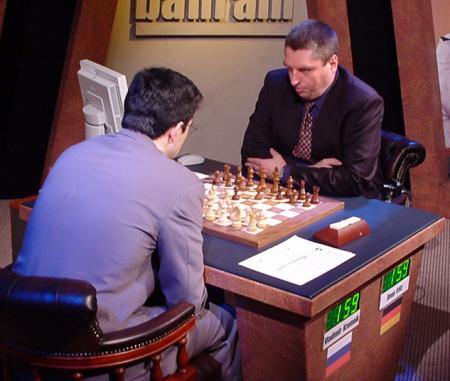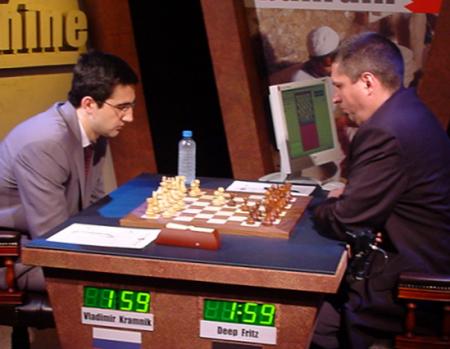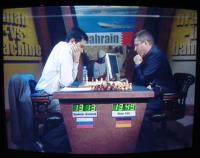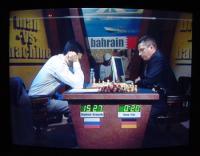
Fritz operator Mathias Feist giving Vlady the old stare. Well it worked,
kind of, didn't it?
Fritz essayed the Tarrasch Defense against Kramnik's 1.d4. This means an immediate
push of the black c-pawn to blast open the position. Black is left with a lonely
pawn in the middle of the board, but also gets active pieces, crucial for Fritz.
Kramnik again got the queens off the board and then followed known theory to
reach a superior endgame. But this endgame was one Fritz understood and it played
excellently to split the point. Kramnik will have two days to rest up before
the match resumes on Sunday the 13th.

What are they going to play today? Kramnik just before making his third
move.
Team Fritz will have to work hard in that time to come up with something to
use against Kramnik, who has seemed invincible so far. They must try to keep
the queens on the board and to reach position in which Fritz can demonstrate
the tactical mastery that its famous for. Until now Kramnik has brilliantly
avoided such positions, and game four was no exception.
Of the millions of spectators watching the game transmission live, only a handful
would have known that game five followed a known game until past move 20! Kramnik's
long-time assistant, Spanish GM Miguel Illescas, had briefed the champ on this
line and this knowledge proved valuable as Kramnik played the opening almost
as quickly as Fritz. Only on move 22 did Kramnik pause to consider the different
paths available for prosecuting his advantage. With a pair of powerful bishops
and an active rook, the Grandmasters watching the game thought that white had
fair chances for a win.




Kramnik on the monitors during game four of this match
"Against another GM I think Kramnik would win this most of the time,"
opined four-time UK champion Julian Hodgson after move 22. "25.Ra6 is a
good move, a very good move," this from Grandmaster and London Times columnist
Raymond Keene, "Black is going to have a very difficult time in this ending."

Kramnik explaining his thought on the endgame in the postmortem
And a difficult time it was, until Kramnik surprisingly decided to avoid the
most promising line on move 26. Instead of the expected 26.Bd4 the world champion
simplified the position with 26.Rxc6. This gained an extra pawn but allowed
Fritz to exchange the bishops and reach a position in which it could calculate
the draw with near perfection. From that move on the computer evaluation never
showed any concern over losing the game. Kramnik pressed on hoping for a Fritz
mistake for another 15 moves.

Frans Morsch from Team Fritz in the press conference with his opponent
Frederic Friedel of ChessBase said that Sunday's game five was practically
a must win situation. Fritz's programmer, Dutchman Frans Morsch, said about
game five that "anything can happen. We still have a few arrows in the
quiver." He added that as well as avoiding closed positions they now knew
they should avoid queen exchanges whenever possible in order to have serious
winning chances against Kramnik.
Kramnik leads the match 3-1 with two wins and two draws. All eight games of
the match will be played even if Kramnik reaches the needed 4.5 points. Fritz
will have the advantage of the white pieces in game five and will have to pull
out all the stops. King's Gambit, anyone? At least we don't have to worry about
past chess match scandals, like the players kicking each other under the table
or accusations of secret messages in yogurt or parapsychologist mercenaries.
Compared to those items from human-human matches, playing a computer is perfectly
normal!
Kramnik,V (2807) - Deep Fritz [D34]
Brains in Bahrain Man-Machine Match. Manama (4), 10.10.2002
1.d4 d5 2.c4 e6 3.Nf3 c5 4.cxd5 exd5 5.g3 Nc6 6.Bg2 Nf6 7.0-0 Be7 8.Nc3
0-0 9.Bg5 cxd4 10.Nxd4 h6 11.Bf4 Bg4 12.h3 Be6 13.Rc1 Re8 14.Nxe6 fxe6 15.e4
d4 16.e5 dxc3 17.exf6 Bxf6 18.bxc3 Qxd1 19.Rfxd1 Rad8 20.Be3 Rxd1+ 21.Rxd1 Bxc3
22.Rd7 Rb8 23.Bxc6 bxc6 24.Rxa7 Rb2 25.Ra6 Bd2 26.Rxc6 Bxe3 27.fxe3 Kf7 28.a4
Ra2 29.Rc4 Kf6 30.Kf1 g5 31.h4 h5 32.hxg5+ Kxg5 33.Ke1 e5 34.Kf1 Kf5 35.Rh4
Kg5 36.Re4 Kf5 37.Rh4 Kg5 38.Kg1 Kg6 39.g4 hxg4 40.Rxg4+ Kf5 41.Rc4 ½-½
In the final position white has no way to make progress. Black's rook is perfectly
placed to prevent the white a-pawn from advancing and at the same time the white
king is trapped against the edge of the board.































